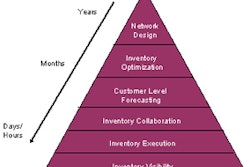
By Andrew K. Reese
In a downturn, every penny of profit is precious. And yet many companies are missing out on an opportunity to improve their profitability because their supply chain functions are decoupled from their pricing processes.
So says Jamie Rapperport, founder and executive vice president for marketing and business development with Vendavo (www.vendavo.com), a provider of enterprise price management and optimization solutions for companies in chemicals, high-tech, industrial manufacturing, consumer products, mill products and distribution.
Historically, Rapperport notes, companies have looked to their supply chain function to focus principally on driving improvements in the cost structure, enabling the company to exploit cost advantages and mitigate cost disadvantages. Supply chain executives have focused to a much lesser extent on "cost to serve," even though in markets like chemicals or other process industries, freight and other delivery costs are a very large component of the end price to the customer. "Having a deep understanding of the freight and other delivery costs for those customers is hugely important for profitability and should be hugely important for pricing," Rapperport says.
As a result, he continues, "Supply chain should be proactively positioning the function as a key driver of pricing decisions. That means that in focusing on managing inventory, managing availability, you want to look at the profitability of those products sold into any given set of end customer segments." Supply chain, as a baseline, should be providing accurate, timely visibility into capacity constraints, overall inventory position, available-to-promise inventory and the cost of servicing any given customer to the commercial team that is interfacing with that customer.
Supply chain can also be an invaluable asset to the sales team by providing insights into the company's competitive stance from a supply chain perspective. Top of that list is capacity utilization at competitors' plants, the location of those plants and competitors' approximate delivery costs. This is especially relevant in a capacity-constrained industry where freight/delivery is a major cost element, Rapperport suggests. "We've had customers that have driven very significant gains in profitability by understanding whether they are advantaged or disadvantaged from a capacity utilization and delivery cost perspective, and then developing a price based on that information," he says.
It is not enough, however, to simply link supply chain to the sales team around discrete pricing decisions for a particular customer in a particular deal. Rather, the best results are achieved by creating an ongoing process and an organizational framework within which the company can make consistent price-profitability decisions that build on one another over time. In other words, each pricing decision should be reflective of all the pricing that the company has done before. That entails having visibility into a transaction history from a pricing perspective, down to a very granular level: which products have been sold to which customers through which channels at what profitability. This includes not just price, but also such data as any on- and off-invoice discounts and cost-to-serve elements.
Rapperport points out that his company, Vendavo, offers a solution designed to provide the kind of framework within which companies can both set overall pricing strategies and make individual pricing decisions that align with those strategies to drive increased profitability. "Best-in-class companies take a fine-grain view to pricing, viewing price not as monolithic but as highly dependent on the kinds of information that we've discussed, and Vendavo's platform allows you to take that fine-grain view rather than a manage-by-the-averages monolithic view," he says.
In part, what Vendavo offers could be seen as a reaction to the empowerment of Procurement that has taken place over the past decade as supply management executives have gained access to increasing amounts of data, and increasingly powerful analytical tools, that allow them to take a much more systematic, data-driven approach to what they are buying and how much they are paying for it. In a sense, that has put the suppliers at a disadvantage. However, enterprises have been sitting on a vast amount of supply chain-related data that are not available to buyers, and that information is tremendously valuable and should be used at deal time. Vendavo, Rapperport says, is giving sellers access to that information and empowers them with the same level of data-driven analytical capability that Procurement has had for some time. Now, ironically, it is up to Supply Chain to come to the rescue of the sales organization by helping to drive more intelligent — and more profitable — pricing decisions. ¦
In a downturn, every penny of profit is precious. And yet many companies are missing out on an opportunity to improve their profitability because their supply chain functions are decoupled from their pricing processes.
So says Jamie Rapperport, founder and executive vice president for marketing and business development with Vendavo (www.vendavo.com), a provider of enterprise price management and optimization solutions for companies in chemicals, high-tech, industrial manufacturing, consumer products, mill products and distribution.
Historically, Rapperport notes, companies have looked to their supply chain function to focus principally on driving improvements in the cost structure, enabling the company to exploit cost advantages and mitigate cost disadvantages. Supply chain executives have focused to a much lesser extent on "cost to serve," even though in markets like chemicals or other process industries, freight and other delivery costs are a very large component of the end price to the customer. "Having a deep understanding of the freight and other delivery costs for those customers is hugely important for profitability and should be hugely important for pricing," Rapperport says.
As a result, he continues, "Supply chain should be proactively positioning the function as a key driver of pricing decisions. That means that in focusing on managing inventory, managing availability, you want to look at the profitability of those products sold into any given set of end customer segments." Supply chain, as a baseline, should be providing accurate, timely visibility into capacity constraints, overall inventory position, available-to-promise inventory and the cost of servicing any given customer to the commercial team that is interfacing with that customer.
Supply chain can also be an invaluable asset to the sales team by providing insights into the company's competitive stance from a supply chain perspective. Top of that list is capacity utilization at competitors' plants, the location of those plants and competitors' approximate delivery costs. This is especially relevant in a capacity-constrained industry where freight/delivery is a major cost element, Rapperport suggests. "We've had customers that have driven very significant gains in profitability by understanding whether they are advantaged or disadvantaged from a capacity utilization and delivery cost perspective, and then developing a price based on that information," he says.
It is not enough, however, to simply link supply chain to the sales team around discrete pricing decisions for a particular customer in a particular deal. Rather, the best results are achieved by creating an ongoing process and an organizational framework within which the company can make consistent price-profitability decisions that build on one another over time. In other words, each pricing decision should be reflective of all the pricing that the company has done before. That entails having visibility into a transaction history from a pricing perspective, down to a very granular level: which products have been sold to which customers through which channels at what profitability. This includes not just price, but also such data as any on- and off-invoice discounts and cost-to-serve elements.
Rapperport points out that his company, Vendavo, offers a solution designed to provide the kind of framework within which companies can both set overall pricing strategies and make individual pricing decisions that align with those strategies to drive increased profitability. "Best-in-class companies take a fine-grain view to pricing, viewing price not as monolithic but as highly dependent on the kinds of information that we've discussed, and Vendavo's platform allows you to take that fine-grain view rather than a manage-by-the-averages monolithic view," he says.
In part, what Vendavo offers could be seen as a reaction to the empowerment of Procurement that has taken place over the past decade as supply management executives have gained access to increasing amounts of data, and increasingly powerful analytical tools, that allow them to take a much more systematic, data-driven approach to what they are buying and how much they are paying for it. In a sense, that has put the suppliers at a disadvantage. However, enterprises have been sitting on a vast amount of supply chain-related data that are not available to buyers, and that information is tremendously valuable and should be used at deal time. Vendavo, Rapperport says, is giving sellers access to that information and empowers them with the same level of data-driven analytical capability that Procurement has had for some time. Now, ironically, it is up to Supply Chain to come to the rescue of the sales organization by helping to drive more intelligent — and more profitable — pricing decisions. ¦



















